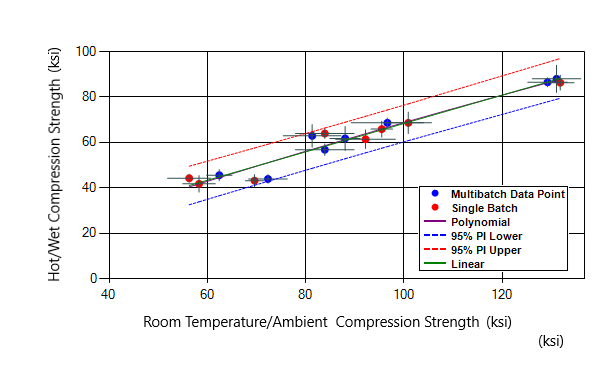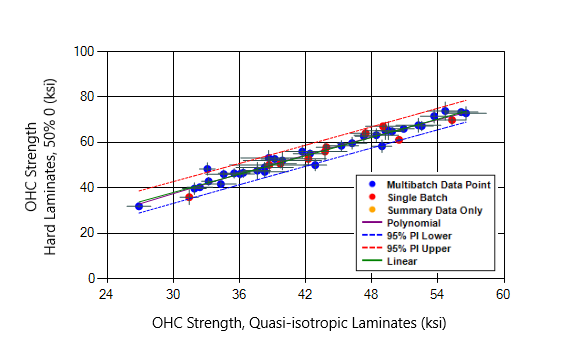Estimating composite properties using data from similar materials
CW columnist Dan Adams explores methods for estimating composite mechanical properties using similar materials.
In my January 2019 column, I discussed methods to determine whether properties obtained from mechanical testing of composites are correct — or even reasonable. One of the methods focused on comparing test results in question to those available in public databases for similar composite materials. However, test results for similar materials cannot always be found. In this column, we consider using available data from similar composite materials to estimate properties when no test results are available.
The need for mechanical property estimates is a common occurrence when performing initial design and analysis of composite structures. Often only a limited set of properties is available from the material supplier’s data sheets. Additionally, testing may be performed to determine the most important properties for the intended application. However, when performing finite element analyses (FEA), a complete set of three-dimensional stiffness properties must be input, including in-plane and out-of-plane properties for the modulus of elasticity, E, Poisson’s ratio, ν, and shear modulus, G. When such lamina stiffness properties are not available, the natural tendency is to try to estimate them, often using available data from similar composite materials. Once the lamina stiffness properties of a composite material with either unidirectional or woven fiber forms are known, stiffness properties for any multidirectional laminate of interest may be calculated using laminated plate theory1.
In addition, strength properties are required to predict failure and establish margins of safety. Unlike stiffness properties, however, many strength properties cannot be accurately predicted for laminates with multidirectional fiber orientations, and therefore must be obtained from mechanical testing. The reason? Progressive matrix damage in multidirectional composite laminates, which can significantly affect laminate strength, is difficult to predict and account for using laminated plate theory. Additionally, predicting these strength properties using progressive-damage finite element analysis is currently an active research area. As a result, there’s also a need to estimate laminate strengths based on laminate test results from similar composite materials.
Even if all of the required stiffness and strength properties are available, it’s often necessary to know the material’s properties at non-ambient environmental conditions. The most common environmental conditions for polymer matrix composites are hot/wet conditions, at which the matrix material loses stiffness and strength, and cold temperatures, at which the matrix material loses ductility. The need for mechanical properties at these non-ambient conditions provides even further needs for available data from similar materials to provide material property estimates.
While once a challenge to find published data for similar materials, there now exists multiple publicly-available databases for a variety of polymer matrix composites, including:
- the Advanced General Aviation Transport Experiments (AGATE) database2, developed for commonly used composites of use in the general aviation industry in the 1990s;
- the National Center for Advanced Materials Performance (NCAMP) database3, initiated in 2005 for composites of use in the aerospace industry and
- the Composite Materials Handbook (CMH-17)4, which includes polymer matrix composites of general interest.
As a result, it is often possible to obtain datasets for similar composite materials that include lamina stiffnesses and strengths, often including some properties at non-ambient environmental conditions. Additionally, stiffness and strength properties of selected multidirectional composite laminates are often available. The most common laminate tested is a quasi-isotropic laminate (25% 0-degree layers, 50% ±45-degree layers, 25% 90-degree layers). However, properties from other “hard” laminates (40-50% 0-degree layers) and “soft” laminates (8-10% 0-degree layers) are sometimes available as well.
Once the desired mechanical properties have been identified for similar composites, they can be used to estimate properties for which no test results are available. One method of doing so is by establishing ratios of properties for similar materials, and applying this ratio to the material of interest. For example, if the shear modulus G23 is needed for the material of interest and G12 is available, the ratio of G23 to G12, or G23/G12, is calculated for the similar material and used to estimate G23 for the material of interest using the equation
.
At this point, the reader may be asking what is a similar material? For starters, similar implies that the composite material has the same type of fiber (for example, carbon fiber), the same type of matrix material (for example, epoxy), and the same fiber form (for example, unidirectional tape or woven). Further, it’s important to assess whether the desired mechanical property is considered a “fiber-dominated” property or a “matrix-dominated” property, and use material properties with the same characteristic for establishing property ratios as described above. Considering unidirectional tape fiber forms as an example, the fiber-direction (0-degree) stiffness E1 and tension strength S1+, are fiber-dominated properties, whereas the 90-degree stiffness E2 and tension strength S2+ are considered matrix-dominated properties. Note that in the example above, both the in-plane shear modulus G12 and the interlaminar shear modulus G23 are matrix-dominated stiffness properties.

Fig 1. D-TEST plot of quasi-isotropic laminate compression strength at hot/wet versus room temperature/ambient conditions for unitape carbon fiber/epoxy materials.
Recent efforts to utilize material databases to estimate properties of composite materials have led to the development of the analysis tool D-TEST5,6 (Database-Trend Evaluation and Synthesis Tool) by Materials Sciences LLC (Horsham, Pa., U.S.). D-TEST uses a database-driven knowledge base to provide comparisons of test results and statistical analyses from similar composite materials for use in estimating mechanical properties. Users can access D-TEST at www.materials-sciences.com/d-test. The current D-TEST database consists of lamina and laminate properties for both carbon fiber and glass fiber polymer matrix composite materials obtained from the public databases listed above as well as a significant number of U.S. government-funded programs. D-TEST allows the user to generate plots comparing mechanical properties of composites that are selected based on a consistent fiber type, resin type and material form. Such plots are used to identify consistent property correlations and establish the appropriate factors from which mean values of unmeasured properties may be estimated.
In addition, the same methodology may be used to estimate these properties at the non-ambient environmental conditions mentioned previously. Fig. 1 shows a D-TEST plot of the compression strengths of several quasi-isotropic unitape carbon fiber/toughened epoxy composites, in which the strength at hot/wet conditions is plotted versus the strength at room temperature/ambient conditions. The data shows a linear relationship between the compression strengths at these two environmental conditions. From this relationship, the hot/wet compression strength of a similar composite material could be estimated based on test results performed on the material at room temperature/ambient conditions.

Fig 2. D-TEST plot of Open-Hole Compression (OHC) strength of hard laminates (50% 0°) versus quasi-isotropic laminates for unitape carbon fiber /epoxy materials.
Since quasi-isotropic laminates are most commonly tested, laminates with other percentages of 0-degree, ±45-degree, and 90-degree layers may be estimated using test results from similar materials. Additionally, coupon-level structural properties of composite laminates, such as open-hole and filled-hole tension and compression strengths (commonly referred to as notched laminate strengths) as well as laminate bearing strengths may also be estimated. As an example, Fig. 2 shows a D-TEST plot of the open-hole compression (OHC) strengths for “hard” laminates (50% 0-degree layers) plotted versus the OHC strength for quasi-isotropic laminates for unitape carbon/epoxy composites. From this plot, the OHC strength of a “hard” laminate could be estimated for a similar composite material based on OHC test results from a quasi-isotropic laminate. In general, results to date indicate that general property trends, including ratios between coupon-level structural properties and similar laminate strength tests performed using the same composite laminate, are consistent across similar composite materials5,6.
References
1Gibson, R. F. “Principles of Composite Material Mechanics,” 4th Edition, CRC Press, 2016.
2Advanced General Aviation Transport Experiments (AGATE) database, www.niar.wichita.edu/agate/
3National Center for Advanced Materials Performance (NCAMP) database, www.niar.wichita.edu/coe/ncamp.asp
4Composite Materials Handbook - 17 (CMH-17), Volume 2: Materials Properties, SAE International, Rev. H, 2018.
5Meyers, C.A., Cicalese, M.J, and Caiazzo, A.A., “Innovative Methodology For Composite Structural Allowables and Analytical Validation, Proceedings of CAMX 2015, Dallas TX, Oct. 26-29, 2015.
6Rousseau, C.Q, Meyers, C., and Storage, T., “Use of Historical Data Trends for Accelerated Structural Design Allowables Development,” Proceedings of CAMX 2018, Dallas TX, Oct. 15-18, 2018.
Related Content
Carbon fiber/flax landing gear achieves 54% weight reduction via tailored layup optimization
Fuko’s Biogear showcases how strategic composite material distribution and natural fiber damping properties can lightweight and enhance critical aerospace structure performance.
Read MoreAIMM Center for advanced composites NDT opens in Ogden, Utah
Attendees from SpaceX, Northrop Grumman, Hill AFB, 47G and others joined CICNDT and Omni NDE to demonstrate the latest in robotic CT, RT, shearography, thermography, laser UT and metrology.
Read MoreSchrödinger advances materials informatics for faster development of next-gen composites
Cutting time to market by multiple orders of magnitude, machine learning and physics-based approaches are combined to open new possibilities for innovations in biomaterials, fire-resistant composites, space applications, hydrogen tanks and more.
Read MoreLaser-excited acoustics provide contact-free, nondestructive composites inspection
Xarion’s couplant-free NDT technology uses laser physics and a membrane-free optical microphone, eliminating the requirement for fluid coupling, widening the scope for NDT technology.
Read MoreRead Next
Scaling up, optimizing the flax fiber composite camper
Greenlander’s Sherpa RV cab, which is largely constructed from flax fiber/bio-epoxy sandwich panels, nears commercial production readiness and next-generation scale-up.
Read MoreUltrasonic welding for in-space manufacturing of CFRTP
Agile Ultrasonics and NASA trial robotic-compatible carbon fiber-reinforced thermoplastic ultrasonic welding technology for space structures.
Read MoreNext-gen fan blades: Hybrid twin RTM, printed sensors, laser shock disassembly
MORPHO project demonstrates blade with 20% faster RTM cure cycle, uses AI-based monitoring for improved maintenance/life cycle management and proves laser shock disassembly for recycling.
Read More






















